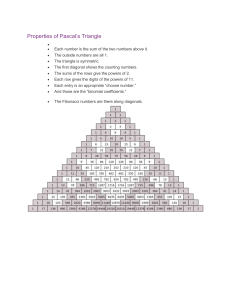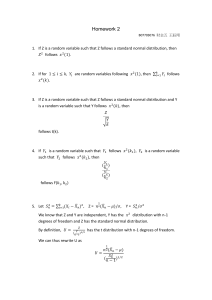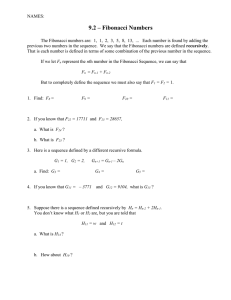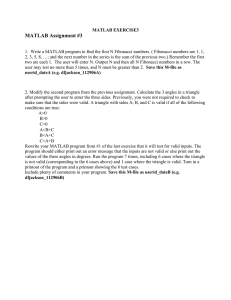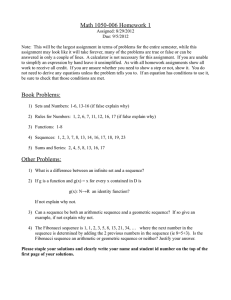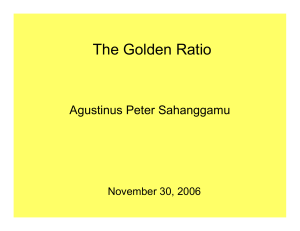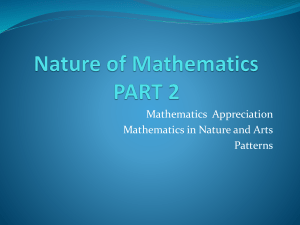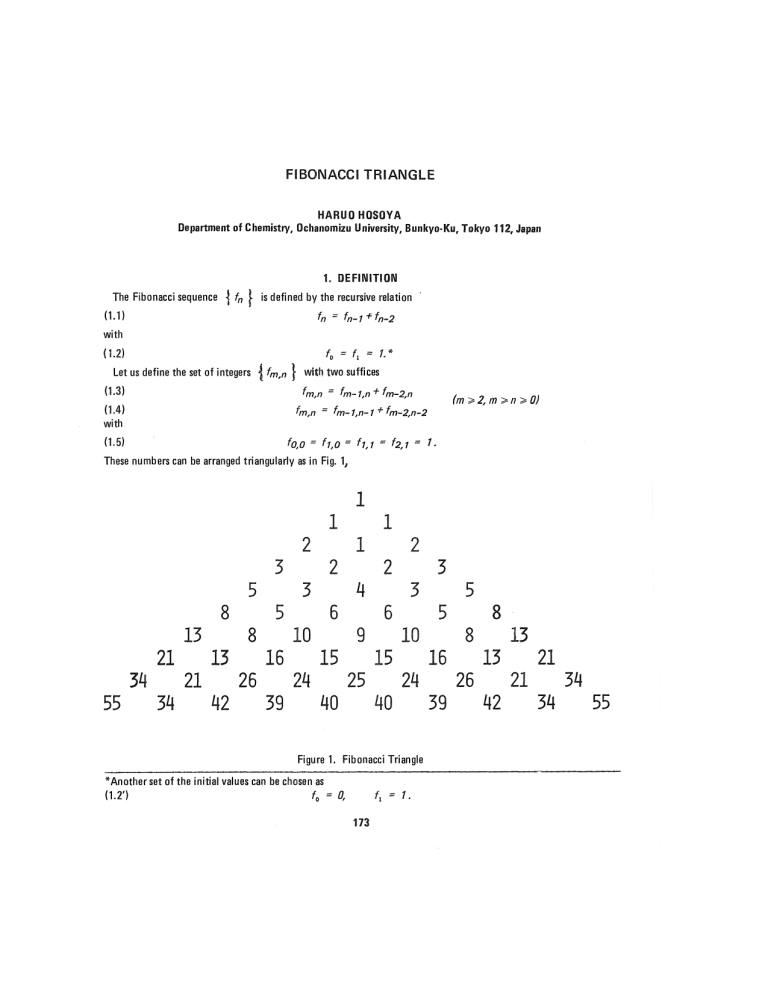
FIBONACCI TRIANGLE
HARUOHOSOYA
Department of Chemistry, Ochanomizu University, Bunkyo-Ku, Tokyo 112, Japan
1. DEFliyiTlOiy
The Fibonacci sequence | fn I is defined by the recursive relation
(1-D
with
fn = fn-1+fn-2
(1.2)
f0 = fx = /.*
Let us define the set of integers | fm,n } with two suffices
(1-3)
=
fm,n
(1-4)
with
fm,n
(1.5)
f0,0=
=
fm-tn*
fm-2,n
(m > 2, m > n > 0)
fm-1,n-1 + fm-2,n-2
ff,0=
fl,1 = f2,1 = 1-
These numbers can be arranged triangularly as in Fig. \
1
1
1
2
1 2
3
2
2
3
5
3
4
3
5
8
5
6
6
5
8
13
8
10
9
10
8
13
21
13
16
15
15
16
13
21
34
21
26
24
25
24
26
21
34
55
34
42
39
40
40
Figure 1. Fibonacci Triangle
* Another set of the initial values can be chosen as
(1.2')
f0 = Q,
fx = 1.
173
39
42
34
55
174
FIBONACCI TRIANGLE
[ ApriS
where the entries in a row have the same/7? and line up according to the value of/? (O-m) from left to right.
Let us call them the Fibonacci Triangle.* A number of interesting relations were found, part of which will be given
in this paper.
2. RELATION WITH THE FIBONACCI NUMBERS
As evident from the definitions (1.3)—(1.5) we have four Fibonacci sequences in the Triangle;
(2-1)
fm,0 ~ fm,m
(2.2)
fmfi
= fm,m-1
=
fm
=
f
m-1 •
Successive application of (1.3) to itself gives the following relation
(2.3)
fmfn = fk-fm-k,n + fk-1-fm-k-1,n
(1 < k <
m-n-1).
By putting k = m - n - 7 into (2.3) one gets
(2.4)
fm/n
= fm-n-
l'fn+1,n
+
fm-n-2'fn,n
(from (2.1) and (2.2))
=
fn (fm-n-1
+
fm-n-2^ •
It follows then that
(2.5)
fm,n
= fm-n-fn
(m > n > 0).
It means that the Fibonacci Triangle is constructed by the selfcmultiplication of the Fibonacci sequence, or
symbolically,
(2.6)
| fm,n } = \ fm } X { fn \ .
In other words the Fibonacci Triangle is the 2-dimensional Fibonacci sequence. Then extension to the ^-dimensional
Fibonacci sequence
(Z7)
{ fml,m2,-,mk
X j fm% \
} = {fm,}
X - X j fmj< }
is straightforward, but we will not duscuss them further.
It is proved from (2.5) or (2.6) that the Fibonacci sequences multiplied by the Fibonacci numbers are seen in the
Triangle alongside of the "roof." That the Triangle is symmetric,
(2.8/
fm,n
=
fm,m-n *
is directly proved from (2.5). On the center line of the Triangle the squares of j fn \ are lined up,
fm,m/2 = (fm/2)2
(2.9)
(™ = even).
Application of the Binet's formula
(2.10)
fn = (an+1 a-(1
(3n+1'j/y/s
+ ^5)/2,
P=(1-y/5)/2
to (2.5) gives
(2.11)
fm,n = 1 (am+2 + $m+2) + (- t)n(am-2n
+ f3m~2n) } /S.
The Lucas sequence | gn }•, which is defined by
(2.12)
with
(2.13)
is expressed as
(2.14)
Thus one gets
gn =
g0 = Z
gn =
gn-1+9n-2
gx = 1,
an+$n.
*The author noticed that the term "Fibonacci Triangle" is used for quite a different array of integers. [ 1 ] .
1976]
FIBONACCI TRIANGLE
175
(2.15)
fm,n=\Bm+2+{-Vngm-2n\/5
(2-16)
={9m+2+(-1)m-nQ2n-m\'/S.
In deriving (2.16) the following relation
(2.17)
(-1)ngn
g„n =
was used.
3. MAGIC DIAMOND
As all the entries in the Triangle are generated from four one's (1.5) forming a diamond, any quartet (fmfn, fm-1/ir
fm-l,n-u fm-2,n-i) ' n t n e Triangle generates the nearest neighbors to the four corners and will be called as a "magic
diamond."
Application of (1.3) into (1.4) gives "downward generation"
fm,n + fm-1,n
(3-D
+
fm-1,n-1
+
fm-2,n-1
=
f
m+2,n+1
}
m illustrated in Fig. 2a. Similarly one gets "upward generation"
(3-2)
fmrn - fm-1,n ~ fm-1,n-1
+
=
fm-2,n-1
fm-4,n-2
as in Fig. 2b.
"Leftward generation" and "rightward generation" (Figs. 2c,d) are obtained respectively as
(3.3)
and
(3.4)
DOWN
fmfn + fm-1,n ~ fm-1,n-1 ~ im~2,n-1
=
fmfn - f m > ifn + fm- i/n- / - fm-2,n-1
=
fm-1,n-2
f
m- 1,n+1 •
LEFT
UP
Figure 2. Magic Diamond
From (2.5) one gets
(3.5)
fm,n'fm-2,n-1
"
fm-1,n-1'fm-1,n
RIGHT
176
[April
FIBONACCI TRIANGLE
or
(3.6)
fm,n * fm~1,n * fm-1,n-1
X fm-2,n-1 = h
which shows the stability of the "magic diamond" (see Fig. 3).
It is verified from (2.5) that the four numbers at the corners in any parallelogram are stable like an "Amoeba."
(3-7)
fm^n • fm~k-Sl,n~k
=
fm-kfn-k ' fm-Sifn •
Figure 3 Amoeba
4. CRAWLING CRAB
The sum of the three entries in any downward triangle (fm n, fm-j
long as the Crab crawls sideways teee Fig. 4a),
(4.D
Proof.
nt
fm-1 n-1)
fm,n + fm-1,n + fm-1,n-1 = fm,Z +fm-1tZ + fm-1,l-1
or a
"Crab" is kept constant as
(m - 1 > n. S. > 1).
From (1.3) and (1.4) one gets
(4-2)
fm+1,n
=
fm,n + fm-1,n
=
fm,n-1
+
f
m-1,n-2
and
W-3)
fm,n
+ f
m- 1fn + fm- 1,n-1 = fm,n-1 + fm- 1,n-2 + fm- l,n-1 •
This relation is transmitted along a given row/7? and yields (4.1).
It is easy to derive from (4.1) the following relation
W.4)
fm,n + fm. itn + fm~
1ell-1
- f m+ / •
Application of (1.3) to (4.4) gives
fm+1,n + fm-1,n-1
(4.5)
=
fm+1-
Combination of (4.4) and (4.5) with proper shift of suffices one gets the transmission property pertinent to an upward triangle (Fig. 4b),
(4-6)
fmfn + fmfn-1 ~ fm- 1,n-1 = fm •
5. ROLLING DUMBBELL
The relation (4.5) means that the sum of any two vertical neighbors in the Fibonacci Triangle is kept constant for
a horizontal movement. Add up the both sides of the two equations derived from (4.5) by substituting (m = m + 2,
n=n + 1) and (m = m -2, n = n - 1), subtract (4.5) from the sum, and one gets
(5.D
f
m+3,n+1
+
fm-3,n-2
=
fm+2 + fm-1
=
2fm+i.
1876]
FIBONACCI TRIANGLE
177
Figure 4. Crawling Crab
More generally one gets the "Rolling Dumbbell" relation (Fig. 5a)
(5.2)
fm+2k+1,n+k
+
=
fm-2k-1,n-k-1
hk'fm+l
=
fm+2k+1,m+1
(from (2.5)).
By putting m = m - 2 and n = n - /into (4.5) one gets
(5.3)
f m - y//7„ 7 + fm-3,n-2
= f
m-1 -
Subtraction of (5.3) from (4.5) followed by substitution m = m + 1 and n = n + 1 gives
fm+2,n+1 ~ fm-2,n-1
(5.4)
= f
m+1 •
This is extended to the expression
(5-5)
fm+2k,n+k-
fm-2k,n-k
= hk-l'fm+l
= fm+2k,m+1
.
which is illustrated in Fig. 5b.
6. RELATION WITH THE TOPOLOGICAL INDEX
The present author has defined the topological index ZQ for characterizing the topological nature of a non-directed
graph G [ 2 ] . Anon-adjacent number p(G,k) for graph G is defined as the number of ways in which k disconnected
lines are chosen from G; p(G,Q) being defined as unity for all the cases. The topological index ZQ is the sum of Ihe
p(G,k) numbers.
It is shown [2] that the non-adjacent numbers and the topological index of a path progression S/v* are given by
(6.1)
[N/2]
,
(6.2)
k=0
The topological index of a series of path progressions recurses,
(6-3)
ZSN
= ZSN^+ZSN^2
,
as the Fibonacci sequence (1.1). This is a special case of the composition principle (a recursion formula) of ZQ,
(6.4)
ZQ =
ZQ^+ZQ®^
* A path progression S/\/ is a graph composed of linearly connected N points. A point is S1 and a line joining a pair
of given points is S2 and so on.
FIBONACCI TRIANGLE
[April
m-2 (—)
—
I m*1
m*
m+2
m-3 ©
I
m-4
T=2
I
m+3
m-5
<p
m+5
A"
?
_
—
I
m+4
©
m-6
9 ?
?
*m+
m+1
= 3
©
(-
= 8
A 4
m+6
©
©
Figure 5. Rolling Dumbbell
where G - c is a subgraph of 6 derived from G by deleting line fi, and G 8 c is further derived from G - c by deleting
all the lines which were adjacent to line c in £
In Fig. 6 a graphical equivalent of the Fibonacci Triangle is given, where the "roofs" are omitted owing to their redundancy. Note, however, that in this case (1.3)—(1.5) should read
(1.3')
(14')
(1.5')
f
'm,n ~ 'm- 1,n + 'm-2,n
= f
*
,+f o o
m,n ~ fm- 1,n-1 + fm-2,n-2
fU
= I
(m > 3, m-
f2,1 = fl,2 = 2,
1 > n > 1)
f2,2 = 4.
Except for the difference in the boundary conditions all the relations pertinent to the Fibonacci Triangle hold for
the topological indices of the trangle array of the graphs in Fig. 6.
REFERENCES
1. V. E. Hoggatt, Jr., and Marjorie Bicknell, "Triangular Numbers," The Fibonacci Quarterly, Vol. 12, No. 3 (Oct.
1974), pp. 221-230.
2. H. Hosoya, "Topological Index and Fibonacci Numbers with Relation to Chemistry," The Fibonacci Quarterly,
Vol. 11, No. 3 (Oct 1973), pp. 255-266.
1976]
FIBOWACCi TRiAWGLE
/
\
/ A A \
/ A A A \
/ ' A AAA,
\
Figure 6. Graphical Equivalent of Fibonacci Triangle
ACKNOWLEDGEMENT
The author would like to thank the editor, Dr. V. E. Hoggatt, Jr., for his suggestion of the name "Amoeba" for
Figure 3.
*******
179
